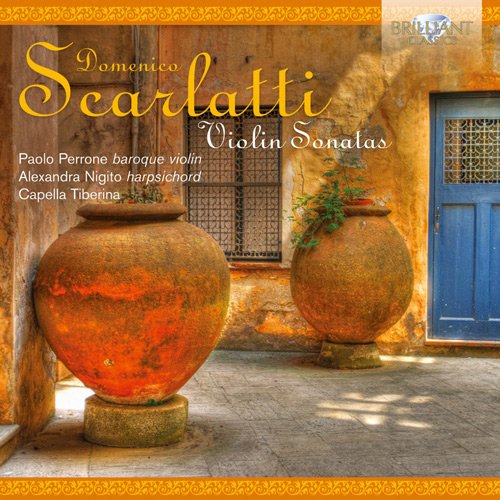Capella Tiberina, Alexandra Nigito & Paolo Perrone - Scarlatti: Violin Sonatas (2013)

Artist: Capella Tiberina, Alexandra Nigito, Paolo Perrone
Title: Scarlatti: Violin Sonatas
Year Of Release: 2013
Label: Brilliant Classics
Genre: Classical
Quality: FLAC (image + .cue, log, scans)
Total Time: 77:16 min
Total Size: 403 MB
WebSite: Album Preview
Tracklist:Title: Scarlatti: Violin Sonatas
Year Of Release: 2013
Label: Brilliant Classics
Genre: Classical
Quality: FLAC (image + .cue, log, scans)
Total Time: 77:16 min
Total Size: 403 MB
WebSite: Album Preview
Solo Sonata in D Minor, K.89/L.211/P.12
I. Allegro
II. Grave
III. Allegro
Solo Sonata in C Minor, K.73/L.217/P.80
I. Allegro
II. Minuetto
III. Minuetto
Sonata in G Minor, K.88/L.36/P.8
I. Grave
II. Andante moderato
III. Allegro
IV. Minuet
Sonata in F Major, K.78/L.75/P.26
I. Giga
II. Minuet
Keyboard Sonata in F Major, K.82/L.30/P.25
Sonata in D Minor, K.90/L.106/P.9
I. Grave
II. Allegro
III. Tarantella
IV. Allegro
Keyboard Sonata in F Major, K.94/P.27
Solo Sonata in E Minor K.81/L.271/P.13
I. Grave
II. Allegro
III. Grave
IV. Allegro
Keyboard Sonata in C Minor, K.84/L.10/P.45
Keyboard Sonata in F Major, K.85/L.166/P.24
Sonata in D Minor, K.77/L.168/P.10
I. Moderato e cantabile
II. Minuetto
Keyboard Sonata in C Major, K.132/L.457/P.295
Solo Sonata in G Major, K.91/L.176/P.11
I. Grave
II. Allegro
III. Grave
IV. Allegro
Amid Domenico Scarlatti's extensive output of over 550 keyboard sonatas lie a small number of works that, given such traits such as figured bass, multi-movement structure and even bowing like articulation, were probably originally written for solo instrument (such as violin) and continuo. In their third recording for Brilliant Classics, members of the Cappella Tiberina present a selection of these works, experimenting with different scorings which historical sources show were common throughout the Baroque repertoire – hence K78 is presented on the theorbo, while K132 is played as a harpsichord solo.
The pieces are certainly not without their technical challenges; four-part chords and uncomfortable multiple-stops suggest that K88 was probably written for mandolin, though it is here skilfully negotiated by violinist Paolo Perrone. Ranging from ambitious works to more modest ones, these continuo sonatas document a fascinating corner of the Baroque master's oeuvre and simultaneously reveal the beginnings of the soon-to-emerge Classical style. Capella Tiberina's historical interpretations offer a fresh take on this engaging music.
The pieces are certainly not without their technical challenges; four-part chords and uncomfortable multiple-stops suggest that K88 was probably written for mandolin, though it is here skilfully negotiated by violinist Paolo Perrone. Ranging from ambitious works to more modest ones, these continuo sonatas document a fascinating corner of the Baroque master's oeuvre and simultaneously reveal the beginnings of the soon-to-emerge Classical style. Capella Tiberina's historical interpretations offer a fresh take on this engaging music.
![Eshon Burgundy - Safe Place (Bossa Nova Jazz) (2025) [Hi-Res] Eshon Burgundy - Safe Place (Bossa Nova Jazz) (2025) [Hi-Res]](https://www.dibpic.com/uploads/posts/2025-12/1766079194_cover.jpg)

![Betty Carter - The Music Never Stops (2019) [Hi-Res] Betty Carter - The Music Never Stops (2019) [Hi-Res]](https://www.dibpic.com/uploads/posts/2025-12/1765896843_bcmn500.jpg)

![Ready Player 3 - Ready Player 3 (2025) [Hi-Res] Ready Player 3 - Ready Player 3 (2025) [Hi-Res]](https://www.dibpic.com/uploads/posts/2025-12/1766128773_cover.jpg)



